
Recent Research Pushes Back First Kiss 1000 Years.
Poetry and songs in praise of lovers’ kisses date back centuries. It’s easy to live in the Western world and assume that kissing is a universal, common, instinctive, and globally practiced way to express affection, respect, or desire. But we’d be wrong. Although humans have been locking lips for at least 1000 years longer than we realized, about half the world’s cultures don’t associate kisses with romance or passion.
Considering that our simian relatives the Bonobo apes spend a lot of time kissing one another, among other far naughtier things, and even chimps engage in platonic kisses, it’s not unreasonable to conclude that kissing is in our genes. If that were true, why would Trobriand Islanders instead nibble on one another’s eyelashes?
Charles Darwin observed that Malay women would squat on the ground while their men hovered over them and took a whiff of their scent. Sniff kissing, where the nose of one person is pressed against the other person’s forehead or cheeks and their scent inhaled, is more common in some Asian cultures, New Zealand, and the islands of Polynesia, where kissing has been more taboo.
It’s likely that cultures that have opted out of the whole kissing experience express sensuality and intimacy differently from those who choose to press their lips together and thus raise the risk of disease transmission. Even among those who indulge in the practice of kissing, context is everything. Is the act one between mother and child? Between lovers? Between men? Between women? Between social equals?
Fifth Century B.C.E. Persian men exchanged kisses on the mouth with those of equal rank but those lower on the ladder received their kisses on the cheek. When Greeks and Egyptians of the same time would kiss, the latter refused to kiss the former on the mouth because they ate beef, which the Egyptians revered as sacred.
The Romans loved kissing. They kissed their lovers, they kissed their spouses, they kissed their families, they kissed their friends. They even kissed their rulers. They kissed so much that the location of the kiss determined the participants’ social status. The Roman marriage ceremony was sealed with a public kiss.
In the Bible, kissing doesn’t always have a very good reputation. In the Old Testament, Jacob steals his brother’s blessing from their blind father with a kiss. Fortunately, the Song of Songs, which is pure God-approved porn, declares at one point, “Let him kiss me with the kisses of his mouth, for thy love is better than wine.”
Speaking of religion and how much the Romans liked to kiss, as the Empire took a nosedive and Christianity gained popularity and acceptance, the meaning of a kiss became more complex. The “holy kiss” of greeting exchanged between early Christians was understood to also facilitate the transfer of the kissers’ anima, or spirit. Maundy Thursday was an annual no-kissing day for early sects of Christians because it was believed to be the anniversary of the kiss of betrayal laid on Jesus by Judas, one of his closest associates.
As Christianity increased its market share, it also increased its emulation of secular hierarchies. While romantic kisses fell out of favor for a few hundred years. Instead, kisses were a physical expression of social order and rank. The Pope had his ring or slipper-covered toes kissed to show respect. The king had his robe and the ground in front of him to receive the kisses of his inferiors.
Fortunately, for those of us who like to kiss, romantic smooching returned toward the end of the 11th Century with the increasing popularity of courtly love. It was a daring break for love, becoming an independent decision made by the couple involved and not a matter to be decided by their blood family or society at large. This was some cutting-edge relationship theory.
Chances are good that none of this was on the mind of the woman whose longing for a kiss from her beloved was inscribed in cuneiform script on a Mesopotamian clay tablet somewhere between 1900 – 1595 B.C.E. That’s 1000 years before we had previously known for sure that kissing existed. “My upper lip becomes moist,” she wrote. “While my lower lip trembles! I shall embrace him. I shall kiss him.”
This does not mean that the first kiss between humans took place 4500 years ago. Science favors the idea that we were kissing long before we were writing. Likely because topics related to sexuality and romance don’t receive the kind of attention or funding that they deserve, Mesopotamian tablets that discussed both platonic and erotic kisses, as well as medical records that relate to disease transmission via a kiss, have been largely unrecognized as reference sources.
Other than the pure prurient joy that comes with knowing that our most distant ancestors (depending on where we’re from) may have known the sublime satisfaction of a kiss, these Mesopotamian documents are 1000 years older than the previous record-holder, a 3500-year-old Bronze Age manuscript from India, where, by 1500 B.C.E., people were rubbing foreheads and noses in greeting. The Kama Sutra includes multiple tips on how to kiss. This may have been useful to Alexander the Great when he left India and introduced kissing to Europe during the fourth century C.E.
For those who do kiss, the question remains as to why. There are a lot of educated guesses but not any solid conclusions. Perhaps it helps humans check out potential mates by getting close enough to check breath and to pick up hormone cues that provide us with useful information. Additionally, for those of us who don’t see kissing as akin to cannibalism, it builds and reinforces emotional bonds.
Alas, it also makes it easier to transfer some diseases, which may well be how HSV (herpes) was introduced to the human population. According to the World Health Organization, two-thirds of the world’s people younger than 50 are infected with herpes. That’s roughly 3.7 billion people carrying the virus despite Emperor Tiberius of Rome banning kisses at state functions to limit disease transfer. By the time humans had reached the Bronze Age, herpes, or something very close to it, was common in Mesopotamia.
Tiberius wasn’t the only leader to ban kissing because of a link between disease and the practice. By the 14th Century, the Catholic Church saw the act of kissing as a gateway to further carnality. Even the government had concerns thanks to the rising threat of the Plague. This was also the reason that Henry VI banned all kissing in England in 1439. In 1311 – 1312, Pope Clement V decreed at the Council of Vienna that “holy kissing” was banned as a gesture of peace and goodwill during mass. Instead, when parishioners wished one another “Peace be with you,” they did so by shaking hands, which continues to the modern era. By the 18th Century, folks were kissing and shaking each other’s hands instead of making out.
Interestingly enough, neither the Japanese nor the French had specific words for the act of kissing, although they both engaged in it, the former in the privacy of the bedroom. In 2014, the term “galocher” was introduced to French slang to refer to kisses with tongues. Nonetheless, the Academie Francaise, which exists to keep non-French words out of the language, still refuses to acknowledge the term.
All of this is because Neanderthals and Homo Sapiens got along well enough to exchange some saliva during pre-historic times and Sumerians got along well enough with writing to mention the practice of touching lips and tongues as in vogue. Ancient Akkadians told stories of both intercourse and kissing, and there’s no knowing how many or how long foraging societies that have left no written records indulged in the pleasure.
There can be no question that modern humanity adores kissing. We kiss our children, our parents, our friends, our pets, our lovers, and our marital partners. It takes 34 facial muscles and 112 postural muscles to successfully form a kiss, and the ideal results include a rush of oxytocin to improve mood, endorphins to make us happy, and dopamine to stimulate our brain’s pleasure center.
Kissing reduces stress, increases relationship satisfaction, and even lowers cholesterol. And, yes, for kissing snobs, it helps weed out those whose techniques or pheromones are not compatible, leaving our lips available to quote e. e. cummings, who wrote, “(So, when kiss Spring comes / we’ll kiss each kiss other on kiss the kiss / lips because tic clocks toc don’t make / a toctic difference / to kisskiss you and to / kiss me.)”






















